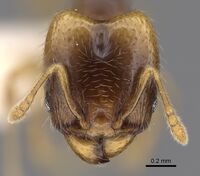Pheidole kasparii
| Pheidole kasparii | |
|---|---|

| |
| Scientific classification | |
| Kingdom: | Animalia |
| Phylum: | Arthropoda |
| Class: | Insecta |
| Order: | Hymenoptera |
| Family: | Formicidae |
| Subfamily: | Myrmicinae |
| Tribe: | Attini |
| Genus: | Pheidole |
| Species: | P. kasparii |
| Binomial name | |
| Pheidole kasparii Longino, 2019 | |
This species occurs in cloud forest to high montane oak forest. It is locally abundant around the type locality. Minor and major workers recruit to ground baits, and workers occur in Winkler samples of sifted litter and rotten wood. Nests have been found under epiphytes on recent branch falls, under epiphytes on clay banks (road cut), in an acorn amongst ground litter, and in a cavity in a low, moss-covered live stem of Siparuna.
Identification
Longino (2019) - Minor: face smooth and shining; vertex margin shallowly emarginate in full face view; promesonotal groove absent; pronotum entirely smooth and shiny; katepisternum shiny, with varying development of faint foveolation; propodeal spines in form of obtuse to right angles, not spiniform; gaster smooth and shining; abundant erect setae on mesosomal and gastral dorsum; tibiae lack erect setae; color red brown to yellow (color variation can be intracolonial).
Major: median hypostomal tooth strongly developed; inner hypostomal teeth very weakly developed, hardly visible, closer to outer hypostomal teeth than to medial tooth, recessed, not on ventral margin of hypostomal bridge; ventral margin of head in profile view convex; scape base terete; face mostly smooth and shiny, with longitudinal carinulae between eye and antennal fossa; propodeal spines in form of short, triangular teeth, < one fifth length of posterior face of propodeum; gastral dorsum smooth and shiny; abundant erect setae on sides of head, mesosomal and gastral dorsum; tibiae lack erect setae.
Measurements, minor worker: HW 0.41, HL 0.43, SL 0.34, EL 0.10, WL 0.47, PSL 0.01, PTW 0.07, PPW 0.09, CI 96, SI 85, PSLI 2, PPI 129 (n=2).
Measurements, major worker: HW 0.79, HL 0.87, SL 0.40, EL 0.12, WL 0.68, PSL 0.02, PTW 0.12, PPW 0.16, CI 91, SI 50, PSLI 3, PPI 133 (n=2).
Measurements, queen: HW 0.87, HL 0.81, SL 0.48, EL 0.26, WL 1.39, PSL 0.00, PTW 0.27, PPW 0.38, CI 108, SL 55, PSLI 0, PPI 139.
A complex of very similar species occurs in wet forests of Costa Rica: Pheidole kasparii, Pheidole nitella, and Pheidole sagittaria. Pheidole kasparii as currently understood is a narrow endemic, known only from the vicinity of the type locality, and allopatric to the other two. Pheidole nitella and P. sagittaria occur on the Atlantic slope of Costa Rica, where they are sympatric.
The minor workers of the complex are not readily distinguishable, sharing the habitus of being very small, almost completely smooth and shining, and with very short propodeal spines that are no more than low angles in profile. The major workers are more distinct. The inner hypostomal teeth of P. kasparii are farther apart and smaller than the teeth of P. nitella and P. sagittaria, and recessed behind the ventral margin of the hypostomal bridge. Pheidole sagittaria has the ventral margin of the head in profile very flat, while on P. kasparii and P. nitella it is more convex. The head of P. nitella is relatively more narrow than the heads of P. kasparii and P. sagittaria (CI ~84 vs. 90-95).
Distribution
Latitudinal Distribution Pattern
Latitudinal Range: 9.57666° to 9.56895°.
| North Temperate |
North Subtropical |
Tropical | South Subtropical |
South Temperate |
- Source: AntMaps
Distribution based on Regional Taxon Lists
Neotropical Region: Costa Rica (type locality).
Distribution based on AntMaps
Distribution based on AntWeb specimens
Check data from AntWeb
Countries Occupied
| Number of countries occupied by this species based on AntWiki Regional Taxon Lists. In general, fewer countries occupied indicates a narrower range, while more countries indicates a more widespread species. |

|
Estimated Abundance
| Relative abundance based on number of AntMaps records per species (this species within the purple bar). Fewer records (to the left) indicates a less abundant/encountered species while more records (to the right) indicates more abundant/encountered species. |

|
Biology
Castes
Worker
Minor
Images from AntWeb
   
| |
| Paratype of Pheidole kasparii. Worker. Specimen code CASENT0637176. Photographer Michele Esposito, uploaded by California Academy of Sciences. | Owned by CAS, San Francisco, CA, USA. |
Queen
Images from AntWeb
   
| |
| Paratype of Pheidole kasparii. Queen (alate/dealate). Specimen code CASENT0637178. Photographer J. Longino, uploaded by University of Utah. | Owned by CAS, San Francisco, CA, USA. |
Nomenclature
The following information is derived from Barry Bolton's Online Catalogue of the Ants of the World.
- kasparii. Pheidole kasparii Longino, 2019: 40, fig. 5 (w.q.) COSTA RICA.
Type Material
- HOLOTYPE: 1 major worker, Costa Rica, San José: 8km S Santa Maria, 9.57666 -83.94911 ±20 m, 1700 m, 25-Jun-2015, cloud forest, under epiphytes (J. Longino, JTL9356) [MUCR, unique specimen identifier CASENT0637174].
- PARATYPES: major, minor worker, dealate queen: same data as holotype [MUCR]; same data except 9.56895 -83.94756 ±20 m, 1770 m, 25-Jun-2015, cloud forest, nest under epiphytes (J. Longino, JTL9358) [CAS, DZUP, JTLC, MCZC, USNM].
Description
see the identification section above
Etymology
In honor of ant ecologist extraordinaire, Mike Kaspari.
References
References based on Global Ant Biodiversity Informatics
- Longino J. T. 2019. Pheidole (Hymenoptera, Formicidae) of Middle American wet forest. Zootaxa 4599: 1-126

